|
|
So you own a hearse? While quite a few people know the hearse they own is cool, stylish and attracts attention like no other car on the road, many do not know the history behind them or other interesting facts that bring these cars from cool to amazing.
A brief history of the automotive hearse - By Zachary Byron Helm for Hearseclub.com
I want to preface this article with a
brief statement. This article is a very broad overview that is only meant to
impart some cursory knowledge of the history of funeral coaches. This is the
first of more to come that will cover other aspects of hearse history. In
writing this there is a lot of information I am not including here. Why? Because
the amount of minutiae I
could obsess over is endless. I've read articles about hearses that go on and
on, telling you who did what, what street it happened on, how many bowls of
Cherios the person had that morning, etc. Straight up, I'm not going to write
like that. For one, it's boring and this isn't a contest to see who knows the
most obscure trivia about hearses, secondly I've had sex. Once you've had sex
you tend to give a whole lot less of a damn about the trivialities of your hobby
and just sorta enjoy the big picture because you don't have the time to obsess
over the details. I hope for all your sakes you're in the same boat.
The Begining:
It helps to think of the funeral industry
as a big, lumbering special ed student. It's slow to adapt and doesn't usually
take new directions very well, if at all. I mention this because the funeral
industry, as well as the general public was reticent to give the motorized
hearse a chance in the beginning.
The exact date of the first hearse could be a matter of contention as some
publications claim that the first non-horse hearse was built May 1st 1908 by
General Vehicle Company of New York and was electric, capable of running on
several cells for up to 35 miles at a speed of 10 MPH on a single charge,
although motorized ambulances and home brew creations in the early 1900's, with
1905 being the first of these to appear as hearses. Some sources hold
Philadelphia PA undertaker Oliver H. Bair as the first in the profession to use
a motorized hearse. By contrast, the first ambulance of this type (also
electric) was employed in 1901 which illustrates the funeral industries
reluctance to adapt to the new trend. The following political cartoon appeared
in Life The Humorous Journal reflecting public sentiment at the time.
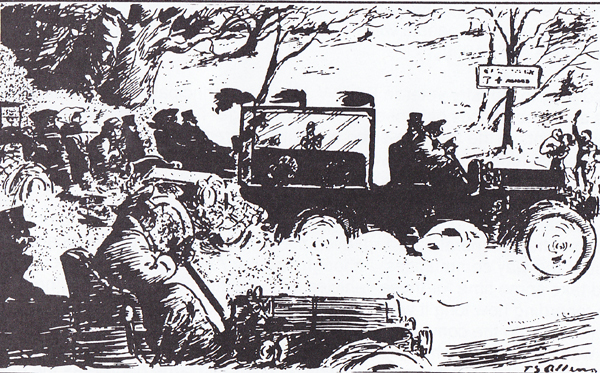
How very droll of them. Probably written and inked by this
guy...

Funeral vehicles were a bit slow to take off at first and the sentiment was reflected in this cartoon. The thinking was that 20 MPH was a blistering and undignified speed that should be left out of solemn funeral processions and reserved for things such as the three toed sloth.
Crane and Breed, established in 1853 was
at the time one of the largest casket and horse drawn hearse and ambulance
manufactures in the States and went on to introduce the first production hearse
on June 15th 1909.
Crane and Breed had an interesting marketing strategy which was to inform
funeral homes that the move to motorized coaches was inevitable by informing
them, point blank - "The demand for it has arrived. We cannot avoid it. You
cannot. Nobody can" which was basically their way of telling the consumers
to go eat root because they were getting automobile hearses whether they liked
it or not. You have to admire that kind of forward marketing strategy, ie:
"Fuck you, it's happening, now act like you're enjoying it" which
meant that not only was Crane and Breed the first to mass produce the hearse as
we know it today, but they were also the first to employ the Borg
mentality.
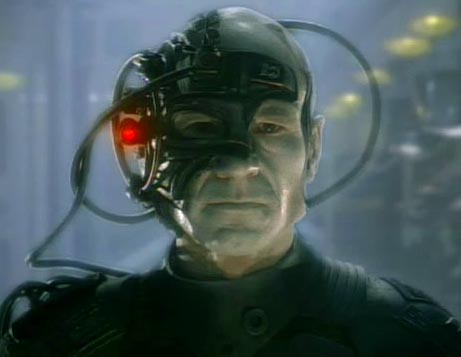
"Resistance is futile. Your mourning needs will adapt to service US"
The first hearses were noisy, slow, crappy on gas and generally giant pieces of crap that broke down all the time with costly repairs...come to think of it...in over 100 years can someone explain how exactly that has even remotely changed?
A Short Timeline of Hallmark Hearse and Ambulance Events
1909 - The first ever fully motorized funeral. This funeral was performed by H.D. Ludlow for Chicago area cab driver W.A. Pruyn. There was only one problem. Ludlow didn't own a motorized hearse. He quickly contacted a business associate, C.A. Coey Auto Livery Company which was not only capable of making a hearse for him, but also kept consistent with the naming theme wherein EVERY damned person involved in the first full auto funeral flat out refused to use their first names and opted instead to use only 2 initials. Seriously, go look at the first part of this paragraph.
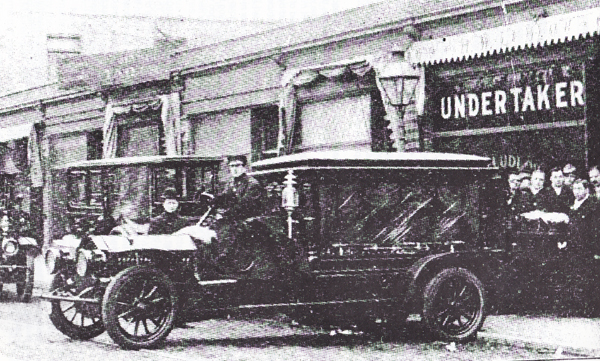
C.A. Coey transferred the body of an old four column Cunningham horse drawn hearse and slapped it onto the chassis of an old opera bus. That's right, one of the first hearses EVER was a MODIFIED car, so yeah...suck it PCS. This was actually how a great number of motorized hearses were to come about in the following years as well.
1920 - The first limo style hearse. Following the lines of popular passenger limos of the times, the limo style appears and gives another option that is vastly different from the hand carved column style hearses.
1922 - First incarnation of the flower car. This was the first incarnation as a vehicle with an open bed. Pretty much looked like a truck. This was the Keystone casket wagon "Style 54".
1923 - First appearance of the landau bar. The landau bar was an epic achievement in design, namely the fact that it gave the car a piece of chrome that to this day only about 150 people can actually NAME it aside from calling it things like "The squiggly chrome thing on the side of the hearse" the landau was intended to mimic the metal gear on the sides of convertibles of the era to lend a classier look to the cloth topped hearses.
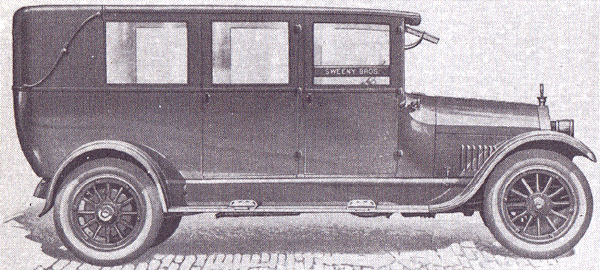
1926 - First "Side Ways" loading coach by Eureka. Eureka goes on to make the 3 way coach tables used by Henney and other coach builders. The original side loading hearse was created by Wilber S. Myers, who was not only an innovator because he created a new way to load hearses, but also because he refused to turn his first name into only a set of initials, another first for the funeral industry.
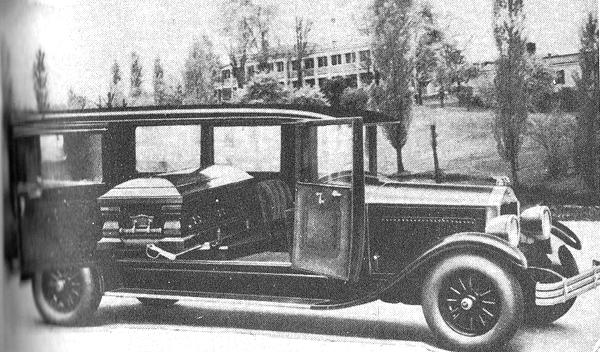
1942 - S&S changes hands. Willard C. Hess and Charles A. Eisenhardt buy the controlling stock in Sayers and Scovill
1943 through 1945 - Wartime production. In addition to committing genocide we can attribute yet one more total dick move to the Nazis...a couple of shitty years for hearse and ambulance production. Wartime efforts meant limits on new production, effectively closing the doors for many coach makers. Those that were produced were not heavy on non-essentials like chrome and some makers, such as Superior, resorted to government manufacturing contracts during wartime. Superior itself made ambulances and rocket launchers, winning them the distinction of the Army-Navy "E" pennant for excellence. Eureka and Miller also joined the fray, though most coach builders who sought government contracts reported financial losses for this period.
The most decorated manufacture of this period was Flxible who was awarded the Guidon Award, the Minute Man Flag, and an approved quality rating from the Army Air Force. Not only that, they were also awarded the Army Navy "E" award, which the Army probably figured they needed since they were clearly missing that particular vowel in their name but Flxible didn't take the hint and continued misspelling their own name for decades to come.
1948 - Last appearance of carved panel coaches...bummer.
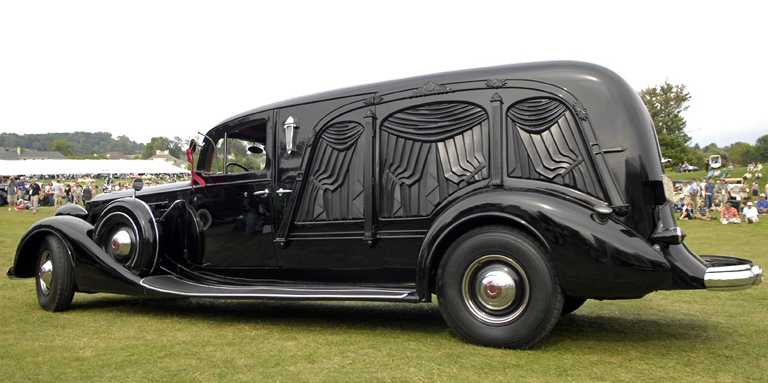
You know maybe someone should make a modern version, that might look pretty awesome!
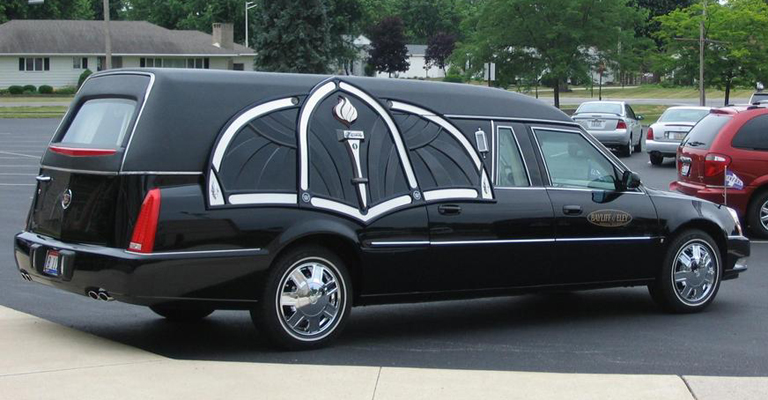
OR NOT.
1959 - 1964 The biggest tailfin ever. The 59 Cadillac is introduced...and sinks
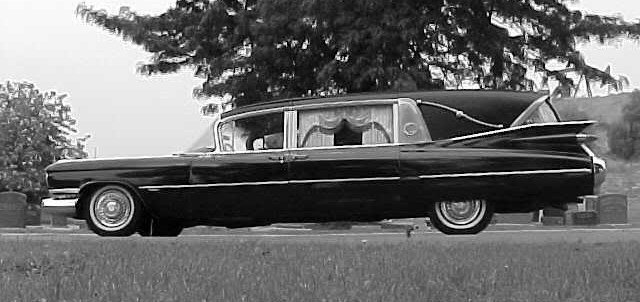
"What NOW, bitches!?"
It has been rumored that Cadillac burying the tailfin later in 1964 due to backlash from safety concerns but that assumption is in fact false.
The book, Unsafe At Any Speed, written by Ralph Nader, was released and lambasted the automotive industry for a lack of compliance to safety concerns, one of which was the condemnation of aggressive styling (Dagmar chrome bumper bullets, giant fins, stacked headlights) could cause more damage to pedestrians. Many people have cited this book as a contributing factor on the decision to phase out tail fins (The theory being that people might get impaled on large tail fins...you know, if the car was driving backwards) though this is a fallacy as the book itself was released in 1965 and Cadillac officially made the last year of their fin 1964. The decision to deflate the fin can actually be attributed to a mediocre public response at the time.
1960 - Comet Sells their name to Ford. Comet, which built non-Cadillac conversions, most notably on the Oldsmobile framework was approached by Ford Motor Company who wanted to buy the company name for use on a new line of cars. Ford, who was not aware that there was another consonant in the alphabet that could replace the letter "C" paid them a whole shit ton of money for the name while Comet just changed their name to Cotner Bevington in honor of the firms founders, while quietly muttering the word "Suckers!" under their breath on their way to the bank.
1964 - Wayne (Miller Meteor) acquires Cotner Bevington
1966 - S&S
Solidifies Stance as Snotty Dicks. In a move that becomes atypical for
S&S, the company releases a really dickesh ad with the headline "Of
COURSE it costs more" exemplifying their position as an uppity kinda
company that catered to some uppity kinda funeral directors. The hearses, which
sold for a few thousand dollars more than Superiors of the same era also usually
had fewer features and storage room. Just saying.

1973 - Ambulances in trouble. New legislation is passed dictating stricter criteria for ambulances and their ability to triage. In previous years it was not unusual for local funeral homes to run ambulance services as well (Think about that for a minute, conservative ass people from 1960's getting picked up from an accident and a HEARSE shows up to get them. Yes, the hearse had a big red light on it, but I somehow doubt that made people any more relieved)
Ambulance services did not necessarily
have any CPR training and in some cases were just assigned to scoop and run. The
good news is that nowadays the people who come to get you and save your life
aren't the same people who get your business if they fuck it up and you end up
dead along the way. Stabilizing the patient is now an actual concern and
requirement. The other silver lining is that newer restrictions threatened the
sedan based ambulance industry because van and Type III box style ambulances
where what it took to carry all the equipment. Why was that good? Because the
coachbuilders decided that those lame ass van based ambulances could go kick
rocks because they were going to make THIS-
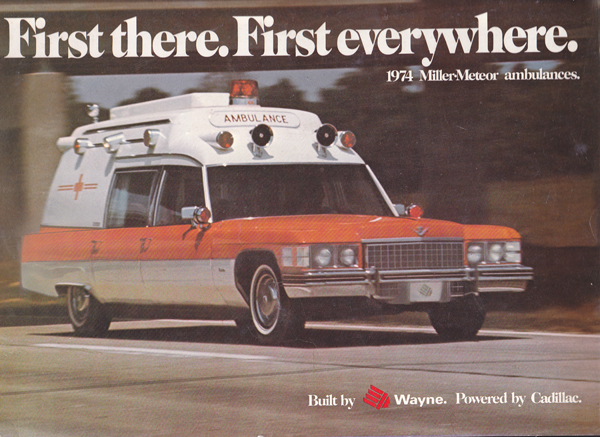
What you are looking at here is a Criterion by Miller Meteor (Superior made
their own version called the XL) it's what would happen if you had a cock that
was 255.25 inches long, 64 inches wide (the headroom inside the rear
compartment) and that cock had red lights, the loudest siren ever made and was
made of metal. In short, this IS the most bad ass ambulance ever made.
Not only did it meet the new criteria for ambulances, it did it on a sedan base
that provided far better comfort and style. The bad news? It only lasted a few
years. There were 2 made in 1973 and while quite a few over the next few years
this class eventually died out leaving us with van and Type III
ambulances.
1977 - Cadillac downsizes the Fleetwood in response
to rising gas prices in the 1970's Gas Crisis, which means that the funeral
coach industry downsized too.
1979 - Last Cadillac ambulance produced -
Officially the last sedan based ambulance was made in 1979 by Superior and the
last combination ambulance/hearse was made in 1985 by Bayliff out of Norwalk
Ohio.
1984 - "IT" happens. Ghostbusters, and the most annoying hearse related comment ever: the yelling of "Ghostbusters" and "Who ya gonna call!?" both come out simultaneously bringing the overall enjoyment of driving a hearse or ambulance down a few fucking notches for everyone involved.
1997 - Hearses
Downsized Again. The funeral car industry was once again forced to
downsize in 1997 when, despite a promise to the industry to continue making them
until at least 2000, General Motors ceased production of rear wheel drive
Cadillacs. This forced a major retooling of the hearse as we know it and out of
pure spite some funeral coach manufacturers decided to do the most mean
spirited, spiteful and downright terrible thing they could think of in
retaliation... they made hearses out of Caprices. I actually like the Caprice
hearses, but I am one of like 5 people who actually do, so I figured the joke
was good enough to include here.
This article was compiled from numerous sources but a great deal of the information cited here is from various articles and books written by Thomas A. McPherson who has written numerous, very informative books on the subject, most notably American Funeral Cars & Amnulances Since 1900. The book is out of print but you can find it, as well as others on Ebay or swap meets and are a great way to get more information on your hobby.
BACK TO HEARSE RESOURCE CENTRAL